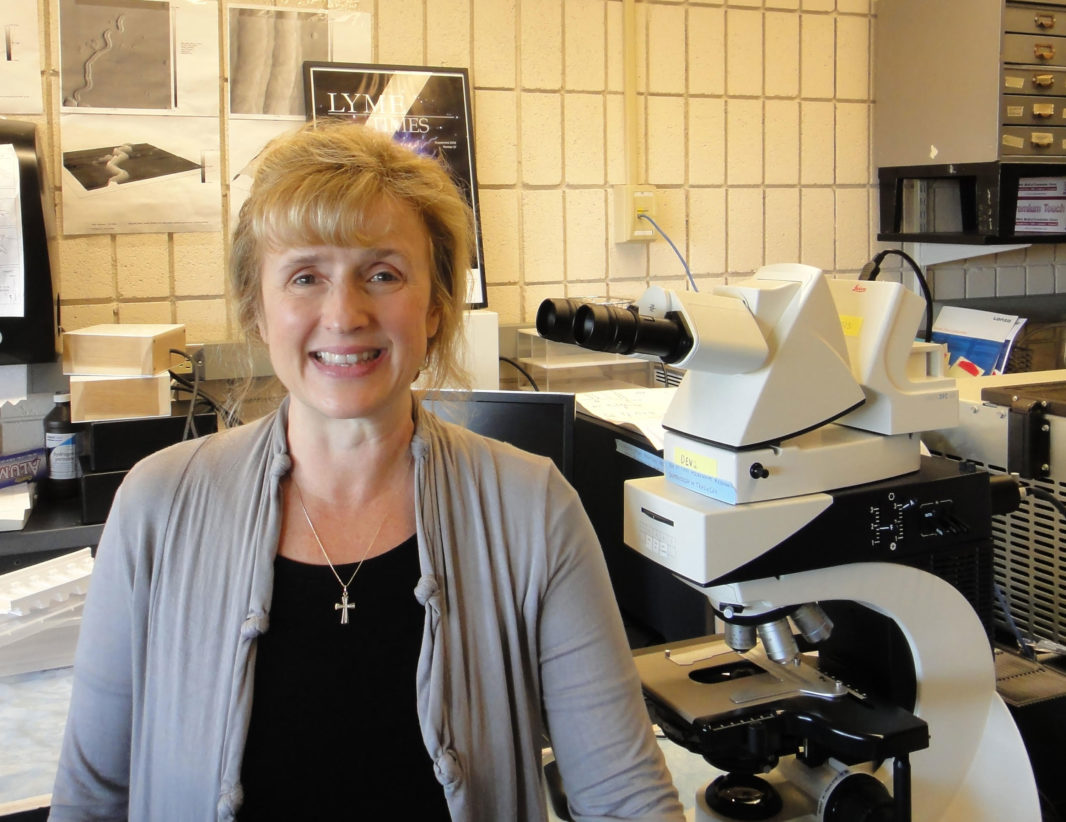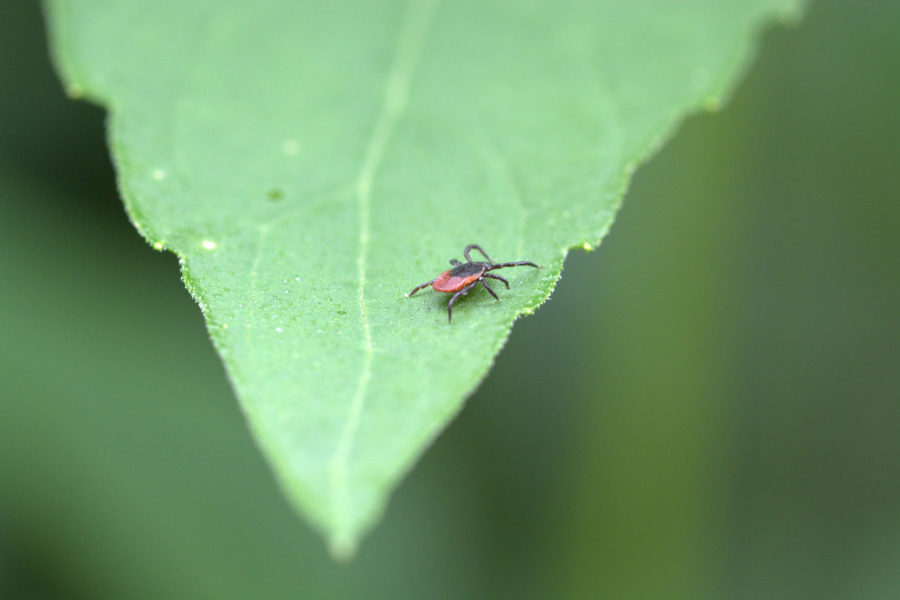Lyme disease: It’s a scary health condition that rears its head every spring here in the Northeast, as the weather warms and ticks come out. Ticks thrive well through fall.
Anyone who has ever been diagnosed with Lyme disease knows how debilitating it can be on the body. For Dr. Eva Sapi, professor of cellular and molecular biology at the University of New Haven, her Lyme diagnosis was “devastating.” She started experiencing symptoms as soon as she started her faculty position in 2001.
Lyme disease is caused by the bacterium Borrelia burgdorferi and is transmitted to humans through the bite of infected ticks. Symptoms can include extreme fatigue, stiff joints and fever.
“It took me a good two or three years to understand what was going on, get treatment and finally start feeling better,” she says.

Courtesy Eva Sapi
Dr. Eva Sapi, a Lyme disease researcher and survivor
Previously, Sapi had dedicated much of her scientific career to ovarian and breast cancer research, but after having a personal encounter with Lyme disease and meeting other patients who had had similar experiences, she changed her course.
Sapi created the Lyme Disease Research Group at the University of New Haven in 2004 and began studying the disease. She wanted to figure out why Lyme disease was so hard to treat.
“I felt like I had a mission here,” she says. “I’m very passionate about this.”
Her passion led her to an incredible discovery. She was the first person to ascertain the presence of Borrelia biofilm in infected human skin tissue, a finding that might explain why antibiotic treatments for Lyme don’t always work.
Sapi’s findings were published in the European Journal of Microbiology & Immunology, an international peer-reviewed online journal. She’s also been recognized by Massachusetts General Hospital/Harvard Medical School for her research and has showcased her findings at conferences around the country.
5 Things You Don’t Know About Lyme Disease
Although there is more awareness these days around Lyme disease and other tick-borne illnesses, Lyme is still very much a mysterious condition.
Thing 1: Tests for Lyme are not always accurate. If you suspect you might have Lyme disease after experiencing sudden, unexplained symptoms, and you recently spent time in a wooded area, get tested, but not just once, Sapi recommends.
“The test is not one hundred percent. Sometimes, you have to do it a couple of times,” because your body might not have developed antibodies yet during the early stages, which is how the disease is typically detected.
If you are still experiencing symptoms despite a negative test result, Sapi says, “Keep checking for it.”
Thing 2: Antibiotics aren’t always an immediate cure. In rare cases, Lyme disease pathogens can be resistant to conventional antibiotic treatments.
After spending years studying and observing the Borrelia bacterium in vitro and how it reacts to antibiotics, Sapi and her students discovered the bacteria is able to form a biofilm, a type of protective mechanism that is resistant to antibiotics.
“The question, now, is, can we find biofilms in Lyme patients, too?” says Sapi.
More studies with human patient biopsy samples would have to be conducted to confirm the presence of Borrelia biofilm, but Sapi hypothesizes there’s a good chance of this since another study shows how, “Our body temperature is perfect for biofilm formation.”

Stevia is a sweet leaf sugar substitute and may be able to help treat Lyme disease.
Thing 3: There may be a new way to fight Lyme. After reading a 2011 study published in the journal, Nature, which showed how adding sugar to certain antibiotics improved the effectiveness of those antibiotics in eliminating bacterial infections, Sapi decided to conduct her own similar experiment.
“I asked my students to get all kinds of sugar from the store, including sugar alternatives like stevia,” says Sapi. “In the first experiment, stevia had a huge effect. We did it a hundred more times, because I couldn’t believe it.”
The research group published their study titled, “Effectiveness of Stevia rebaudiana whole leaf extract against the various morphological forms of Borrelia burgdorferi in vitro” in 2015.
A separate clinical trial in New York, currently being conducted by Dr. Richard Horowitz, is testing the effectiveness of using stevia extract with antibiotics on human Lyme disease patients.
Thing 4: Health care providers don’t always believe that patients truly have Lyme disease. One would think that a Ph.D. educated biology professor would be taken seriously by health-care providers when describing her symptoms of Lyme disease. Unfortunately, that was not Sapi’s experience.
“When I had Lyme, even though I was diagnosed early, it went to the point that I couldn’t get up from my chair, and nobody believed me,” she says. “At one point, they thought it was all in my head.”
This experience was one of the driving forces behind her switch from ovarian and breast cancer research to Lyme disease. “At least ovarian and breast cancer patients know they have cancer and are getting treatment,” she says. “Here I was, I couldn’t get treatment and I felt like I was dying.”
Meeting with other Lyme patients, she realized they were going through the same “hopeless” experience of two weeks of antibiotics and then being told that they should be fine. “But, they’re not fine,” she says.
Thing 5. Researchers are looking into a possible link between Lyme disease and breast cancer. Sapi says she’s in the very early stages of studying a potential link between breast cancer and Lyme disease. This new work is marked by a particularly difficult time in her life.
“My close friend died last fall and what really shook me was just before she got cancer and passed away, she was very positive for Lyme,” says Sapi. “She was on a round of antibiotic treatment for that when she was also diagnosed with cancer.”
Sapi recalls meeting other patients at conferences who were diagnosed with both breast cancer and Lyme disease and how they urged the scientist to study the link between the two.
She emphasizes that although there is no definite evidence, her hypothesis is that the bacterium Borrelia would use cancer tissue as shelter and perhaps its presence can cause an inflammatory response, dangerously advancing cancer that’s already present.
Sapi will present her first findings of these experiments at a conference of scientists in September in Denver, and at the International Lyme And Associated Diseases Society Conference in October in Boston.



 5 min read
5 min read

